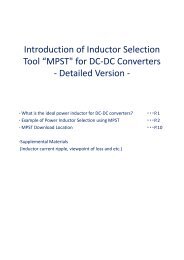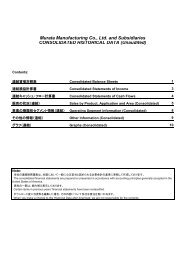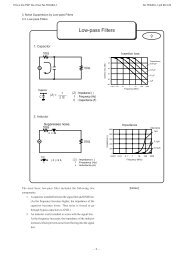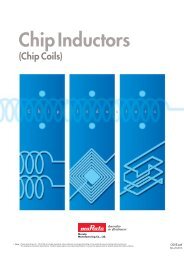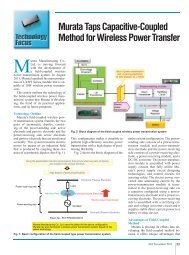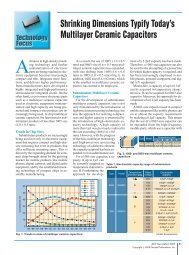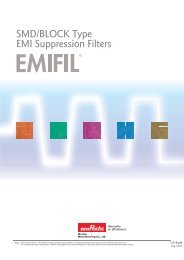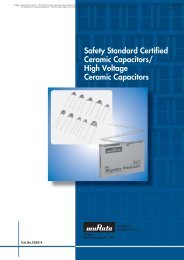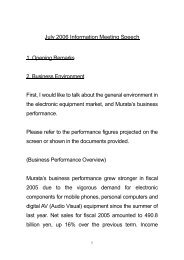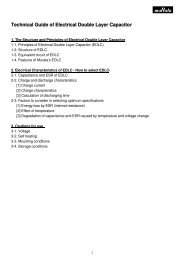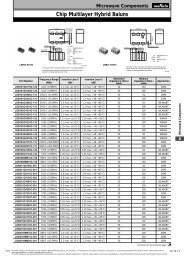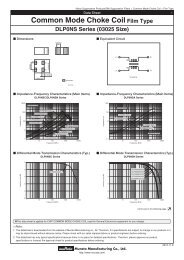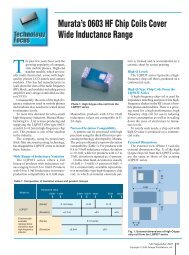Using LFC Technology, Murata Makes Automotive Ceramic Substrates
Using LFC Technology, Murata Makes Automotive Ceramic Substrates
Using LFC Technology, Murata Makes Automotive Ceramic Substrates
- No tags were found...
You also want an ePaper? Increase the reach of your titles
YUMPU automatically turns print PDFs into web optimized ePapers that Google loves.
<strong>Using</strong> <strong>LFC</strong> <strong>Technology</strong>, <strong>Murata</strong> <strong>Makes</strong><strong>Automotive</strong> <strong>Ceramic</strong> <strong>Substrates</strong>Large <strong>LFC</strong> panel<strong>Using</strong> <strong>LFC</strong> <strong>Technology</strong>, <strong>Murata</strong>designs glass ceramics for under-the-hoodenvironments. Inthe 1980s, studies were conductedto find ways to reduce the impedanceof packages for CPUs in order to increasethe speed of mainframe computers.Glass ceramics, or Low TemperatureCo-fired <strong>Ceramic</strong>s (LTCC), featuring lowresistance conductors Ag and Cu and alower dielectric constant material systemshowed great promise.In 1986, pioneering the industry, <strong>Murata</strong>Manufacturing Co., Ltd. establisheda mass-production technology for theLTCC system called Low-temperatureFireable <strong>Ceramic</strong>s (<strong>LFC</strong>) using low-resistanceAg conductors. At the beginning,this <strong>LFC</strong> system was employed as substratesand boards for the high-reliabilityindustrial applications of high-integrationmulti-chip modules. As the computerizationof the automobile advances, it has becomewidely accepted by the automotiveindustry for applications that require robustand high-reliability modules operatingunder harsh environments.Furthermore, with growing global networkingdemands, interest in LTCC-basedembedded function boards for RF communicationsmodules has been increasingdue to the potential for integration anddownsizing of such modules. Likely futureapplications of the LTCC multilayermodule substrates include automotiveradars and proximity sensors for safetyenhancement as well as miniaturized informationcommunications modules forintelligent transportation system (ITS)traffic information systems.Overview of Low-TemperatureCo-Fired <strong>Ceramic</strong>sLow-Temperature Co-fired <strong>Ceramic</strong>s(LTCC) are multilayer glass ceramic substratesmade from Ag or Cu conductorsto form internal circuit traces, and GreenSheet ceramic tapes made of a mixture ofalumina base material and glass materialto form the body.Amodel structure of the LTCC modulesubstrate is shown in Fig. 1 “StructureFig. 1: Structure model of a low-temperature co-fired ceramic substratemodel of a low-temperature co-fired ceramicboard.”The description LTCC is derived froma relatively low firing temperature of900°C (below the melting points of lowresistanceconductor metals such as Agand Cu) as opposed to alumina ceramicsthat are fired at around 1500°C.<strong>Murata</strong>’s <strong>LFC</strong> is an environmentfriendlyglass-and-filler-mixture-type materialsystem using a lead- and cadmiumfreeborosilicate glass.<strong>Murata</strong> Manufacturing Co., Ltd. hasdeveloped the Green Sheet tapes andmatching pastes. These tapes are beingmanufactured in-house from the very beginningof the raw material formulation.Multilayered substrate structures arefabricated by screen-printing technology:first via holes in the Green Sheet areformed to connect upper- and bottom-sideof the tape and the via holes are filled withsilver paste. Then, the pattern of conductortraces is printed on each tape layer usinga screen-printing method, after whicha number of layers are stacked togetherfor firing. <strong>Murata</strong> can offer non-shrinkagesubstrates by using its proprietarypressured non-shrinkage firing methodthat provides superb dimensional accuracyand flatness.Features of PressuredNon-Shrinkage Fired <strong>Substrates</strong>When the Green Sheet is fired using aconventional firing method, the ceramicswill shrink by approximately 20 percentin each direction. Even with the tight controlsover the process and firing conditions,the dimensional tolerance of thefired substrates will be ± 0.5 percent oreven greater.Even more troubling, it is very difficultto control shrinkage uniformly over theentire Green Sheet, and deformations tendto occur in the substrate corners and edges.<strong>Murata</strong>’s <strong>LFC</strong> substrates are formed usingthe company’s proprietary pressurednon-shrinkage firing method, in order tohave control over the shrinkage of the ce-50 AEI April 2005Copyright © 2005 Dempa Publications, Inc.
amic sheets and thereby eliminate suchdeformations to have the dimensional accuracyand flatness.In this pressured non-shrinkage firingmethod, pressure is being applied to theGreen Sheet layers from the top and bottomof the stacked tapes (Fig. 2) at thetime of firing so that shrinkage is controlledto take place only in the directionof the thickness.The substrates manufactured using thistechnique have the following features: forproduction in a large panel form with highdimensional accuracy, <strong>Murata</strong> Manufacturingis currently manufacturing the <strong>LFC</strong>in a panel of approximately 200 × 170mm.The panel’s dimensional tolerance afterfiring is ± 0.05 percent or less, which isan order of magnitude better than that byconventional manufacturing methods. Itis also possible to further increase the dimensionsof panels while maintaining thesaid dimension tolerance intact.For highly flat substrates, meanwhile,the company uses the pressured firingmethod by which printed conductor traceson the Green Sheet are pressed flat duringthe sintering (Fig. 3). This method, inturn, provides the very smooth surfacesof the substrates and realizes the superflatsubstrates with flatness of 5 µm orless per 4 × 4mm area. Warpages in thefour corners of the substrates are also eliminated,thus making it is possible toFig. 2: Pressured non-shrinkage firingtechnique (Fired in the air)Fig. 3: Cross-sectional view of <strong>LFC</strong> substratesFig. 4: Development and commercialization of automotive modules using <strong>LFC</strong> substratesachieve flatness of 100µm or less for 100× 100mm boards.Features of <strong>LFC</strong> Materials<strong>Murata</strong>’s <strong>LFC</strong> substrates, based on itsPb- and Cd-free environment-friendly materialssystem as described earlier, permitthe printing of resistors and the applicationof plating with high reliability.With the company’s plating technology,paste materials for thick-film hybridIC circuits and LTCC substrates typicallyuse Pb-containing glass. Because this kindof glass readily dissolves in acids and alkalis,it makes the application of platingdifficult due to the requirement of alkalitreatment as plating pretreatment.By contrast, <strong>Murata</strong>’s <strong>LFC</strong> substrates,which have no Pb-containing glass, canbe plated with ease in a conventionalNi/Au electroless plating process. ThisNi/Au electroless plating process is compatiblewith Au and Al wire bonding. Byvirtue of the Ni/Au plating applied ontoconductive traces that are co-fired by thepressured non-shrinkage firing method,wire bonding can be performed on the entiresurface area of each individual conductivetrace, enabling narrow-pitch flipchipinstallation.The company’s resistor system can bedescribed as follows. Printed resistors area technology indispensable to allow thehigh-density mounting of multi-chip modules,especially for automotive applicationsand the like. To be more specific,the placement of printed resistors underneathon-board components as well as onthe back surfaces of substrates enables therealization of downsizing and high-densitymounting.Resistors printed on <strong>LFC</strong> substrates usea RuO 2 -based thick-film material, whichis at par with thick-film hybrid IC circuitsin terms of high reliability. These resistorscome in 10Ω to 300KΩ resistance series,and their temperature coefficient is100ppm/°C or less. By means of lasertrimming, resistance values can be adjustedto ±1 percent or less.Examples of Applications<strong>Automotive</strong> electronics technology hasbecome an indispensable factor for the realizationof a safer, more comfortable automobiledriving. Drive-by-wire technology,above all, (automobile driving operationsby a human are translated by sen-AEI April 2005Copyright © 2005 Dempa Publications, Inc.51
sors into electrical signals that are convertedagain into corresponding mechanicalmovements by actuators), is increasinglybecoming diversified.For these automotive applications,higher-reliability smaller-sized modulesare sought. What is more, to secure greatersafety and cabin space, these modules arebeing increasingly being installed in under-the-hoodenvironments (inside enginecompartments) where environmental/ambientconditions are much more severe.From the viewpoint of environmental protection,the use of the lead-free solder forautomotive modules is being studied, howeverit will be extremely difficult to ensurethe durability of such modules, sincesolder stress becomes too large under severetemperature changes of the underthe-hoodenvironment.By using <strong>Murata</strong>’s <strong>LFC</strong> substrates forsuch automotive modules, mounting methodssuch as Ag-filled conductive adhesivesand wire bonding technology, whichare highly resistant to temperature stresses,can be adopted.Further improvements of the Ag-filledconductive adhesives are also underwayat a brisk pace for use with a variety ofchip components.<strong>Murata</strong>’s <strong>LFC</strong> substrates were first commercializedin 1994 by a European automotiveelectric and electronic systemsmanufacturer for use as high-reliability,high-density boards for antilock brakingsystems (ABS).<strong>Automotive</strong> modules using <strong>LFC</strong> aremounted directly onto engines, transmissionsand the like to function as machineintegratedcontrol modules.<strong>LFC</strong> substrates have now been adoptedfor modules for installation on automobileengines by several major Europeanautomotive electric and electronic systemmanufacturers. Beginning this year, theirNorth American counterparts are alsoscheduled to go into the production of automotivemodules also employing theLTCC substrates.In Japan, studies on LTCC-based moduleshave begun in earnest. Some automotiveelectric/electronic equipment manufacturershave already gone into prototypingor low-volume production.In order to realize small-sized high-reliabilitymodules incorporating <strong>LFC</strong> substrates,the procurement and assessmentsof Known Good Dies (KGD) as well asKGD mounting technologies, most notablywire bonding technology, are thekey technologies.<strong>Murata</strong>’s Low-Temperature Co-fired<strong>Ceramic</strong> <strong>LFC</strong> is expected to prod effortsto develop higher-reliability, higher-functionality,higher-density <strong>LFC</strong> substratesfor the wider applications in automotivemodules as well as for the inroads of thecommunications modules to be used inIntelligent Transportation System equipment,which is expected to see a significantgrowth in the future.BibliographyKatsuhiko Naka <strong>LFC</strong>: Low-TemperatureCo-fired <strong>Ceramic</strong>. Material IntegrationNo. 11 Vol. 15 (2002)About This ArticleThe author of this article is KatsuhikoNaka, Chief of the Planning and MarketPromotion Section of the FunctionalSubstrate Department, Components DivisionIII at <strong>Murata</strong> Manufacturing Co.,Ltd.52 AEI April 2005Copyright © 2005 Dempa Publications, Inc.




